Available in Spanish: Cabo Polonio
Cabo Polonio is a projection of land that enters the sea, surrounded and almost completely covered by huge dunes. A few years ago it was rather difficult to reach. Today you still have to get off your bus or car, get into a large off-road vehicle, and shake around at low speed for half an hour along a sandy path. The difference is that before (I'm told) there was only one big four-wheel drive truck which departed from the middle of nowhere and came to what was then a fishermen's village without drinking water or electric power, occasionally inhabited by hippies and other adventurous types; while now there's a whole fleet, a small emporium of vehicles, on an open space with ticket vending booths and public restrooms, and at the end of the road the little village has turned into a still picturesque and rustic but also populous place, with decent lodgings and even a seafood restaurant.
The day was splendid, threatening none of those clouds or those cold winds that had been visited upon us on previous occasions. We took the bus headed for Barra de Valizas and left it a few kilometers before that; there we boarded our 4x4 truck, named El Mamut (the Mammoth), together with a couple dozens of people, and slightly compressed atop its bulge we went down the sandy, wavy road, until we were able to see, far off in the distance, some dunes and a beach of uniform colour, some scattered houses, a turquoise-blue sea. The Mammoth drove along the shoreline for a while, turned left, and let us go in a place no different from any other.
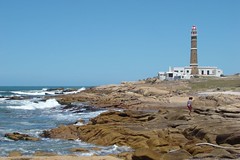 We daubbed ourselves on sunblock (which in the long run would turn out insufficient) and a few steps from there we sat down to eat our sandwich lunch. Even without much wind, the sea looked fabulous; in the distance I thought I saw some surfers. Off the beach you could see some islets with little dark spots on the bare, glittering, surf-beaten rocks: seawolves, aparently gathering just to be together and bask in the sun all day. Beyond, on our side of the coast, there were more rocks and a lighthouse. We headed for it to try and down our meal.
We daubbed ourselves on sunblock (which in the long run would turn out insufficient) and a few steps from there we sat down to eat our sandwich lunch. Even without much wind, the sea looked fabulous; in the distance I thought I saw some surfers. Off the beach you could see some islets with little dark spots on the bare, glittering, surf-beaten rocks: seawolves, aparently gathering just to be together and bask in the sun all day. Beyond, on our side of the coast, there were more rocks and a lighthouse. We headed for it to try and down our meal.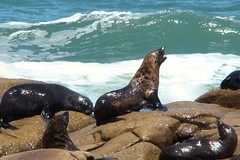 On our way we found a corner where the rocky floor went down up to the sea, and a fenced-out area. A few metres away, some twenty sea lions,* black and brown, glistening with salty waterdrops, were dozing off. You couldn't really say they were active animals in any sense. One that looked like a maned male emitted faint bellows while it lifted itself on its forefins, and somewhat apart a pup scratched itself, oblivious to the rest of the world.
On our way we found a corner where the rocky floor went down up to the sea, and a fenced-out area. A few metres away, some twenty sea lions,* black and brown, glistening with salty waterdrops, were dozing off. You couldn't really say they were active animals in any sense. One that looked like a maned male emitted faint bellows while it lifted itself on its forefins, and somewhat apart a pup scratched itself, oblivious to the rest of the world.* I don't know if this is the proper terminology. In Spanish these are lobos marinos ("sea wolves") rather than leones marinos ("sea lions"), but the names are often mixed up in actual usage. In any case the ones in Cabo Polonio must be South American Sea Lions, Otaria flavescens.
We retraced our steps up the rocks and went to the lighthouse. The climb left us breathless (120 steps!) but the effort was rewarded: from up there our eyes could span not only the ocean and the two islands full of sea lions, but the whole cape, with beaches on both sides and the immense, saffron-yellow dunes in the distance. (I assembled a panoramic picture there which soon, I expect, will be hanging in my room's wall in its full 5-foot-wide glory.)
The sea was inviting. We'd had enough of walking and climbing stairs. We rushed into the beach, towards a place with fewer people around, and went into the water. (As in other occasions, I stayed there much longer than Marisa and went back several times. It was by far the best beach we'd experienced during the whole trip.)
Sunset was upon us. The distant beach was becoming empty and promised peace and a glorious view for meditation. We set ourselves into motion again, the sun burning us from the side, and soon reached the point where the dunes come a few steps close to the sea and there are just lonely beachgoers looking for silence stay. I climbed a dune and looked around. It would've been easy to go down the other slope and climb again and get lost in this fine, hot sand, but I had to hurry back to the beach, where Marisa was waiting, taking those typical I'm-at-the-top-of-the-world tourist-waving-from-afar pictures.
We'd gone towards an end of the cape, which looked far away but not impossibly so, and we hadn't even gotten half-way there, and the lighthouse and the village houses were barely visible already. It wasn't too late, but it wasn't a good idea to wait. When, half an hour later, we rode back on one of the Mammoth's companions and then had to wait for our bus 45 minutes beside the road, we resented not having used up to our last minute in Cabo Polonio; but such is the cruel fate of the tourist who depends on his feet and on other people's means of transportation.
Exhausted on our return, we somehow dragged ourselves to a supermarket and bought mosquito repellent and a quick dinner before falling into deep sleep. There were to be no more beaches for us. Our tired eyes tired and our deep-tanned skins were saying goodbye to the coasts of Uruguay; the next day, before the sun was out, we'd be on our way to Montevideo.
To be continued...

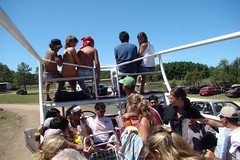
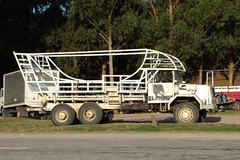

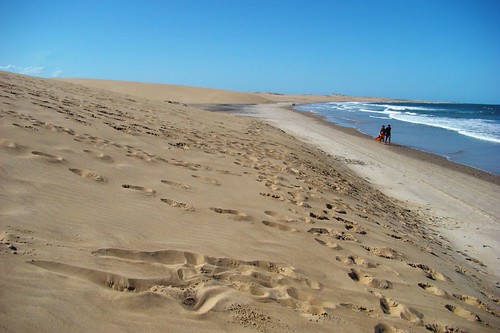













No comments:
Post a Comment
Note: Only a member of this blog may post a comment.